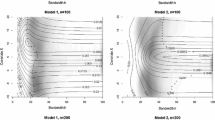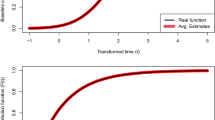Abstract
Survival data including potentially cured subjects are common in clinical studies and mixture cure rate models are often used for analysis. The non-cured probabilities are often predicted by non-parametric, high-dimensional, or even unstructured (e.g. image) predictors, which is a challenging task for traditional nonparametric methods such as spline and local kernel. We propose to use the neural network to model the nonparametric or unstructured predictors’ effect in cure rate models and retain the proportional hazards structure due to its explanatory ability. We estimate the parameters by Expectation–Maximization algorithm. Estimators are showed to be consistent. Simulation studies show good performance in both prediction and estimation. Finally, we analyze Open Access Series of Imaging Studies data to illustrate the practical use of our methods.

Similar content being viewed by others
References
Amari S, Murata N, Muller KR, Finke M (1997) Asymptotic statistical theory of overtraining and cross-validation. IEEE Trans Neural Netw Learn Syst 8:985–996
Cai C, Zou Y, Peng Y, Zhang J (2012) Smcure: an R-package for estimating semiparametric mixture cure models. Comput Methods Programs Biomed 108:1255–1260
Chen T, Du P (2018) Mixture cure rate models with accelerated failures and nonparametric form of covariate effects. J Nonparametric Stat 30:216–237
Ching T, Zhu X, Garmire LX (2018) Cox-nnet: an artificial neural network method for prognosis prediction of high-throughput omics data. PLoS Comput Biol 14:e1006076
Cho J, Lee J, Bang H, Kim S, Park S, An J et al (2017) Programmed cell death-ligand 1 expression predicts survival in patients with gastric carcinoma with microsatellite instability. Oncotarget 8:13320–13328
Csàji BC (2001) Approximation with artificial neural networks. Dissertation, Eotvos Lorànd University
Cybenko G (1989) Approximation by superpositions of a sigmoidal function. Math Control Math Control Signals Syst 2:303–314
Fang HB, Gang L, Sun J (2005) Maximum likelihood estimation in a semiparametric logistic/proportionalhazards mixture model. Scand J Stat 32:59–75
Faraggi D, Simon R (1995) A neural network model for survival data. Stat Med 14:73–82
Farewell VT (1986) Mixture models in survival analysis: are they worth the risk. Can J Stat-Revue Canadienne de Statistique 14:257–262
Ferrara R, Pilotto S, Caccese M, Grizzi G, Sperduti I, Giannarelli D et al (2018) Do immune checkpoint inhibitors need new studies methodology? J Thorac Dis 10:S1564–S1580
Fine TL, Mukherjee S (1999) Parameter convergence and learning curves for neural networks. Neural Comput 11:747–769
Fleming TR, Harrington DP (2005) Counting processes and survival analysis. Wiley, New York
Ganguli M, Du Y, Dodge HH, Ratcliff GG, Chang CCH (2006) Depressive symptoms and cognitive decline in late life. Arch Gen Psychiatry 63:153
Gu C (2013) Smoothing spline ANOVA models, 2nd edn. Springer, New York
Halbert W (1990) Connectionist nonparametric regression: multilayer feedforward networks can learn arbitrary mappings. Neural Netw 3:535–549
Hesse C, Larsson H, Fredman P, Minthon L, Andreasen N, Davidsson P et al (2000) Measurement of apolipoprotein e (apoe) in cerebrospinal fluid. Neurochem Res 25:511–517
Hinsbergen CPIV, Lint JWCV, Zuylen HJV (2009) Bayesian committee of neural networks to predict travel times with confidence intervals. Transp Res Part C Emerg Technol 17(5):498–509
Hornik K (1991) Approximation capabilities of multilayer feedforward networks. Neural Netw 4:251–257
Jiang W, Liu Q, Liu T (2003) Drawbacks of neural network learning algorithms and countermeasures. Mach Tool Hydraul 5:29–32
Katzman JL, Shaham U, Cloninger A, Bates J, Jiang T, Kluger Y (2018) Deepsurv: personalized treatment recommender system using a cox proportional hazards deep neural network. BMC Med Res Methodol 18:24
Kuk AYC, Chen CH (1992) A mixture model combining logistic regression with proportional hazards regression. Biometrika 79:531–541
Law NJ, Taylor JM, Sandler H (2002) The joint modeling of a longitudinal disease progression marker and the failure time process in the presence of cure. Biostatistics 3:547–563
Liu X, Peng Y, Tu D, Liang H (2012) Variable selection in semiparametric cure models based on penalized likelihood, with application to breast cancer clinical trials. Stat Med 31:2882–2891
Louis TA (1982) Finding the observed information matrix when using the EM algorithm. J R Stat Soc Ser B Stat Methodol B 44:226–233
Lu W (2010) Variable selection in semiparametric cure models based on penalized likelihood, with application to breast cancer clinical trials. Stat Sin 20:661
Masud A, Tu W, Yu Z (2016) Variable selection for mixture and promotion time cure rate models. Stat Methods Med Res 27:2185–2199
McCulloch WS, Pitts W (1943) A logical calculus of the ideas immanent in nervous activity. Bull Math Biophys 5:115–133
Mortimer JA (1988) Do psychosocial risk factors contribute to Alzheimer’s disease? Etiology of dementia of Alzheimer’s type. Wiley, New York
Murphy SA, Rossini AJ, van der Vaart AW (1997) Maximum likelihood estimation in the proportional odds model. J Am Stat Assoc 92:968–976
Nielsen GG, Gill RD, Andersen PK, Sørensen TIA (1992) A counting process approach to maximum likelihood estimation in frailty models. Scand J Stat 19:25–43
Othus M, Li Y, Tiwari RC (2009) A class of semiparametric mixture cure survival models with dependent censoring. J Am Stat Assoc 104:1241–1250
Roth M (1986) The association of clinical and neurological findings and its bearing on the classification and aetiology of Alzheimer’s disease. Br Med Bull 42:42
Rumelhart DE, Hinton GE, Williams RJ (1986) Learning representations by back-propagating errors. Nature 323:533–536
Satz P (1993) Brain reserve capacity on symptom onset after brain injury: a formulation and review of evidence for threshold theory. Neuropsychology 7:273–295
Sy J, Taylor J (2001) Standard errors for the Cox proportional hazards cure model. Math Comput Model 33:1237–1251
Tandon R, Adak S, Kaye JA (2006) Neural networks for longitudinal studies in Alzheimer disease. Artif Intell Med 36:245–255
Tsiatis A (1981) A large sample study of cox’s regression model. Ann Stat 9:93–108
Wang L, Du P, Liang H (2012) Two-component mixture cure rate model with spline estimated nonparametric components. Biometrics 68:726–735
Yin G, Ibrahim JG (2005) Cure rate models: a unified approach. Can J Stat-Revue Canadienne de Statistique 33:559–570
Yosinski J, Clune J, Bengio Y, Lipson H (2014) How transferable are features in deep neural networks? Int Conf Neural Inf Process Syst 2:3320–3328
Acknowledgements
The research was supported in part by National Natural Science Foundation of China (11671256 Yu), and by the University of Michigan and Shanghai Jiao Tong University Collaboration Grant (2017 Yu). OASIS-3 data were provided by Principal Investigators: T. Benzinger, D. Marcus, J. Morris; NIH P50AG00561, P30NS09857781, P01AG026276, P01AG003991, R01AG043434, UL1TR000448, R01EB009352. AV-45 doses were provided by Avid Radiopharmaceuticals, a wholly owned subsidiary of Eli Lilly.
Author information
Authors and Affiliations
Corresponding author
Additional information
Publisher's Note
Springer Nature remains neutral with regard to jurisdictional claims in published maps and institutional affiliations.
Supplementary Information
Below is the link to the electronic supplementary material.
Rights and permissions
About this article
Cite this article
Xie, Y., Yu, Z. Mixture cure rate models with neural network estimated nonparametric components. Comput Stat 36, 2467–2489 (2021). https://doi.org/10.1007/s00180-021-01086-3
Received:
Accepted:
Published:
Issue Date:
DOI: https://doi.org/10.1007/s00180-021-01086-3




